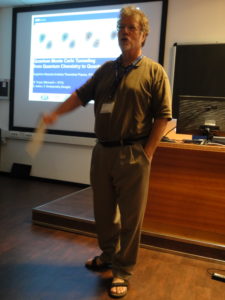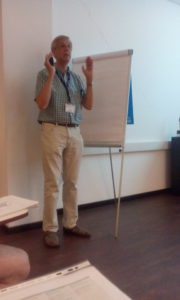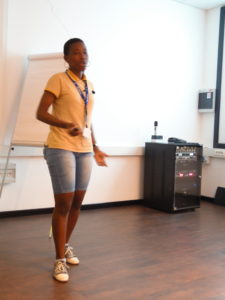Location: Abdus Salam International Centre for Theoretical Physics, Trieste (Italy), 3-7 July 2017
Organizers: David M. Ceperley (University of Illinois at Urbana-Champaign); Michele Ceriotti (Ecole Polytechnique Fédérale de Lausanne); Thomas E. Markland (Stanford University).
Local Organizers: Ali Hassanali (The Abdus Salam International Centre for Theoretical Physics); Sebastiano Pilati (University of Padova).

Summary
The main goal of this interdisciplinary workshop was to gather together physicists and chemists who employ computer-simulation methods based on path integrals to investigate different systems, ranging from chemical and biochemical compounds, to quantum fluids/solids, to ultracold gases. This event allowed a broad community of researchers to create a platform for exchanging knowledge and know-how on path-integral technology and on other approaches to the combined quantum simulation of electrons and nuclei. Furthermore, speakers had the opportunity to showcase the most recent applications to various intriguing quantum phenomena, including, e.g., isotope effects in aqueous systems, quantum fluctuations in enzyme catalysis, quantum phase transitions due to strong correlations, and tunnelling phenomena in molecular systems and in adiabatic quantum computers (alias quantum annealers), thus creating a new bridge between quantum chemistry and quantum computing.
This event took place at the ICTP Adriatico Guesthouse, in a warm and sunny Trieste, allowing participants to enjoy the view of the Adriatic sea and the Miramare park. The format included 24 (long) oral presentations given by invited speakers, 7 short talks selected from contributed abstracts, 21 flash presentations (meant to advertise the content of a poster), and a total of 24 poster presentations. The workshop was attended by a total of 80 participants (including directors and speakers) from 29 countries.
This event has been sponsored by ICTP and by the Psi-k Network.
DESCRIPTION
A growing body of experiments and simulations suggests that nuclear quantum effects play a fundamental role in chemical systems that are rich in light nuclei. They determine important phenomena such as isotope effects in liquid/vapour phase boundaries, in acid-base chemistry processes, and in biochemistry. Recent advancements in the computer-simulation techniques based on the path-integral formalism have opened the scope for their application to these systems. In fact, path-integral simulations have established over the years as a powerful theoretical tool in the research on various condensed matter systems, in particular on quantum-degenerate fluids and solids, such as liquid and solid 4He, electron gases, ultracold atomic gases, and dense hydrogen. This scenario called for an interdisciplinary meeting where (bio)-chemists and condensed matter physicists could share their know-how on how to use path-integral simulations to gain insight into quantum phenomena.
The most relevant topics and challenges that have been addressed are:
- Accelerating the convergence of path-integral simulations.
- Developing higher-order path-integral decomposition schemes.
- Computing dynamical correlations.
- Simulating quantum tunnelling effects.
- Simulating indistinguishability effects.
- Efficient simulations of macroscopic quantum phenomena (superfluidity and supersolidity).
- Isotope effects in aqueous systems.
PROGRAM
The program started with a short introduction given by two of the organizers. First, Michele Ceriotti (EPFL) introduced nuclear quantum effects and their description based on path integrals. Then, David Ceperley (University of Illinois) described path-integral techniques for indistinguishable-particles systems, both Bosons and Fermions.

The program included 24 oral presentations given by invited speakers. These presentations were 50 minutes long (including 10 minutes for questions and discussions), so that speakers had the time to give ample introductions addressed to non-specialists, thus stimulating cross-fertilization between different research fields.
All applicants had been encouraged to submit a research abstract with their application form, and the organizing committee selected, among many very interesting abstracts, seven of these contributions for 20 minutes-long oral presentations. This gave other (often junior) researchers the opportunity to present advanced applications of path-integral methodologies.
The program included also a flash-talk session, in which the 21 participants who presented a poster during the poster session had the opportunity to highlight their research and to further motivate attendees to meet them during the poster session.
Among many outstanding scientific contributions, that one could mention, Sandro Sorella (SISSA) and Carlo Pierleoni (L’Aquila) described novel simulation methods for dense hydrogen. These methods account for nuclear quantum effects using path integrals, and simulate the electronic structure via a variational Monte Carlo method that computes nuclear forces (within a Born-Oppenheimer scheme). A new acceleration method allows Sorella and co-workers to speed-up the molecular dynamics, making it comparably efficient as other simulation methods that neglect the quantum nature of nuclei. On the other hand Pierleoni, has used the Coupled Electron Ion Monte Carlo method. These methods have been used to describe hydrogen at high pressure and the simulations have been compared with existing results for the liquid-liquid transition at 1200K and around 200GPa. The two methods, using different algorithms, are in agreement. They show that realistic simulations based on QMC are nowadays possible and allow one to go beyond the DFT description.
On the second day, Gianluca Bertaina (University of Milan) presented recent results obtained with the path-integral ground-state Monte Carlo (PIGS) method. Used in combination with a stochastic analytic-continuation technique named genetic inversion via falsification of theories (GIFT) algorithm, this method allowed him and his collaborators to determine the ground-state properties of a one-dimensional system of Bosonic particles interacting via a soft-shoulder potential. This model is relevant to describe ultracold Rydberg atoms. They have shown that various phases occur as the density varies. In particular, at strong interactions they observed cluster liquid phases, characterized by the spectrum of a composite harmonic chain. While conventional Luttinger theory is applicable at low density, here this formalism has to be adapted by changing the reference lattice density field, which leads to a peculiar decay of correlations (cluster Luttinger liquids).
On Tuesday there was also a very interesting computationally oriented talk by Ondrej Marsalek from Stanford University. Using some new developments in the efficient simulation of path integral ab initio molecular dynamics, Ondrej showed some beautiful results on the infra-red spectroscopy of acid-water. In particular, using a formulation which allows one to compute quantum dynamics (ring-polymer molecular dynamics), Ondrej and co-workers have computed the vibrational spectrum of low-pH water and used that to help interpret experimental spectra.

On Thursday, Jordi Boronat (University of Catalunya), who has recently been awarded with the Feenberg medal 2017, presented a novel method, recently developed in his group, to extract dynamical ground-state properties from equilibrium path-integral Monte Carlo simulations. The key point of the method is the consideration of time as a complex variable whose phase acts as an adjustable parameter. Thanks also to the use of high-order approximations for the quantum propagator, it is possible to obtain Monte Carlo data all the way from purely imaginary time to values near the limit of real time. As a consequence, it is possible to infer accurately the spectral functions using simple inversion algorithms. This method has so far been tested for simple toy models and compared with exact solutions, showing promising results.

On Friday, Guglielmo Mazzola (ETHZ) and then Estelle Maeva Inack (SISSA&ICTP) presented the results of their recent research on quantum annealers, such as the adiabatic quantum computers recently commercialized by the Canadian company D-Wave Systems. Quantum annealers are quantum-computing devices designed to solve complex optimization problems via quantum annealing, a mechanism in which quantum tunnelling phenomena are exploited to efficiently explore a solutions space in order to (hopefully) find the absolute minimum of a cost function. It is not yet clear whether using devices of this kind one can obtain a computational (quantum) speed-up with respect to classical optimization algorithms. In fact, Mazzola and Inack have shown that in certain computational problems, which are dominated by tunnelling phenomena, the dynamics of quantum Monte Carlo methods such as path-integral Monte Carlo and also the diffusion Monte Carlo algorithm has the same efficiency of an adiabatic quantum computer. Their studies strongly suggest that quantum Monte Carlo algorithms are useful tools to investigate the potential efficiency of adiabatic quantum computers, and they also shed light on the nature of tunnelling within QMC simulations. These findings have implications also in other research fields where quantum tunnelling phenomena are under investigation, in particular in quantum chemistry.
Mariana Rossi from Fritz Haber also gave a talk on Friday on using ab initio molecular dynamics with path integrals to understand the nature of hydrogen bonding interactions in a wide variety of systems. In particular, she showed some results on the effects on nuclear quantum effects in hydrogen bonding in the paracetamol crystal. She has been involved in the development of a python wrapper (i-Pi) that has now made it very easy and practical for people to use with different computational codes.
Overall, this conference was an interesting and productive synergy of people working in the areas of physics and chemistry and we hope that it can be repeated in the future.
LIST OF INVITED TALKS
- Nandini ANANTH (Cornell University): Path Integral Methods for Nonadiabatic Dynamics: Quantum Transitions from Classical Trajectories
- Gianluca BERTAINA (University of Milan): One-Dimensional Soft Bosons across the Liquid – Cluster Liquid Transition
- Massimo BONINSEGNI (University of Alberta): Bound State of a 3He Atom at 4He Crystal-Superfluid Interfaces
- Jordi BORONAT (UPC, Barcelona): Path Integral Estimation of Complex-time Correlation Functions
- Fabio CINTI (NITheP, Stellenbosch): Many-body Physics of Superfluid Dipolar Filaments
- Bryan CLARK (UIUC): Better Variational Density Matrices
- Davide GALLI (University of Milan): Role of the Interaction Core in the Excitation Spectrum of 1D Gases and Liquids
- Markus HOLZMANN (LPMMC, Grenoble): Path Integral Monte Carlo Calculations of Atomic Bose Gases
- Yongkyung KWON (Konkuk U., Seoul): Path-Integral Monte Carlo Study of 4He Adsorption on Carbon Allotropes
- Nancy MAKRI (UIUC): Rigorous Quantum-Classical Path Integral Formulation of Real-Time Dynamics
- Ondrej MARSALEK (Stanford University): Quantum Dynamics and Spectroscopy of Ab Initio Aqueous Solutions: the Interplay of Nuclear and Electronic Quantum Effects
- Glenn MARTYNA (IBM T.J. Watson RC): An Electronically Coarse Grained Model describes Water’s Properties from Ice to the Supercritical Regime
- Dominik MARX (Ruhr-Universitaet Bochum):Quantum Solvation: Hydrogen-Bonding and Chemical Reactions in Superfluids
- Guglielmo MAZZOLA (ETH Zurich): Quantum Monte Carlo Tunneling from Quantum Chemistry to Quantum Annealing
- Burkhard MILITZER (UC Berkeley): Path Integral Monte Carlo Simulations of Warm Dense Matter
- Marco NAVA (ETH Zurich): Quantum Symmetry from Enhanced Sampling: A First Exploration
- Carlo PIERLEONI (University of L’Aquila): Coupled Electron-Ion Monte Carlo Study of Hydrogen under Extreme Conditions
- Igor POLTAVSKYI (Universite’ du Luxembourg): Quantum Transport of Ions through Atomically Thin Materials
- Nikolay PROKOF’EV (UMass, Amerst): Quantum Critical Dynamics in the Relativistic (2+1)-Dimensional Field Theory
- George REITER (University of Houston): Proton Coherent Delocalization in the Ground State of Nanoconfined Water
- Jeremy RICHARDSON (ETH Zurich): Quantum Dynamics, Tunnelling and Electron Transfer beyond Marcus Theory
- Mariana ROSSI CARVALHO (FHI Berlin): Anharmonic and Quantum Effects in H-bonded Systems with First-principles Accuracy
- Sandro SORELLA (SISSA): Nuclear Quantum Effects by Accelerated Molecular Dynamics and Quantum Monte Carlo
- Mark TUCKERMAN (New York University): Hydrogen Diffusion and Lithium Isotope Fractionation: Cases of Competing and (sometimes) Surprising Quantum Effects
LIST OF CONTRIBUTED TALKS
- Giacomo Bighin (Institute of Science and Technology Austria Theoretical Atomic, Molecular, and Optical Physics Group): A diagrammatic approach to composite, rotating impurities
- Braulio Gabriel Brito (Instituto de Ciências Exatas e Naturais e Educação (ICENE) da Universidade Federal do Triângulo Mineiro – UFTM): Quantum effects in the bulk modulus of solid molecular hydrogen
- Amit Ghosal (Department of Physical Sciences, Indian Institute of Science Education and Research ‘IISER’): Classical and quantum melting of Wigner “solids” in confinements
- Estelle Maeva Inack (International School for Advanced Studies, Statistical Physics): Simulating quantum Ising models using the Diffusion Monte Carlo method
- Venkat Kapil (École Polytechnique Fédérale de Lausanne): High order path integrals made easy
- Christoph Schran (Lehrstuhl für Theoretische Chemie, Ruhr-Universität Bochum): Constructing high-dimensional neural network potentials (NNPs) to describe the solvation of protonated water clusters by superfluid helium
- Daniel Schumayer (Department of Physics, University of Otago): Hanbury Brown–Twiss effect in finite-sized Bose gases
The complete workshop program, the Abstracts (including invited talks, contributed talks, and flash talks), the PDF files with the slides used during the oral presentations, the list of posters, and the complete participant list, can be found on the official workshop web-page: http://indico.ictp.it/event/7975/overview
